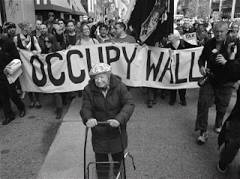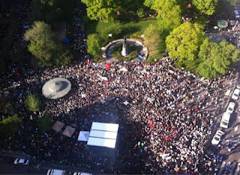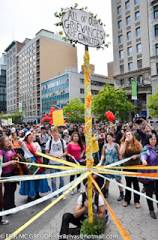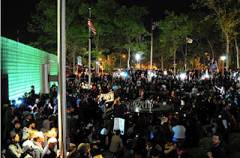"New York Fun Exchange”
Reflections on a Ludic Occupation!
Part 4
continued from page 3
By Benjamin Shepard
May Day
Play and performance continued to be a part of the movement over the months between Occupy Broadway and the May Day events in New York City. Throughout this time, those in the movement experimented with different forms of experimental performance. Some included Spring Training, in which groups of several hundred met in Zuccotti Park, rehearsed moving as a group locked arm in arm, before trekking down to the stock exchange where they rang their own people’s gong simultaneaously with the closing bell, calling out the systems of domination created through Wall Street. Other forms of experimentation included "eviction theater," which took place every night as at midnight during a brief Occupation of Union Square in March and April 2012, when the police closed out the park.
Much of this performance was a warm up for the events planned for May Day.
I had been planning to attend the morning commute and Wildcat March to start off May Day, but between raids and the memo from the NYPD Counterterrorism unit seemingly linking unpermitted parades with disruptive terrorist activities, I thought otherwise, deciding to meet up with Guitarmy.
Walking over to Bryant Park, I was wondering about our capacity to create longer change. Certainly, Occupy can take its place in the long history of street actions which changed New York. Planes crashing into buildings and the movements which grew over the meaning of the War on Terror, AIDS activists crashing a service at St. Patrick’s Cathedral over the church’s hostility to reproductive rights and HIV prevention, workers beating up anti-war activists during the "Hard Hat Riots ," Emma Goldman preaching on labor and anarchism at Union Square – these were moments which helped crystallize a clash of ideas. They dramatized conflict between cultures, imperialism, sexual self- determination, class, and reproductive autonomy. Occupy’s struggle over public space has helped illustrate a class conflict over an expanding disparity of wealth in the U.S. A generation long decrease in union membership mirrors the expansion in inequalities in wealth. Occupy helped identify the problem. It ridiculed a popular, powerful governor as “Governor 1%,” and watched him budge; it built alliances with labor, and pushed to create a space for a different perspective not often seen or heard in increasingly controlled public space. The problem is large. So are the efforts by the powers and principalities to stop Occupy. The problem Occupy has taken on is profound. Yet, the sun was coming out.
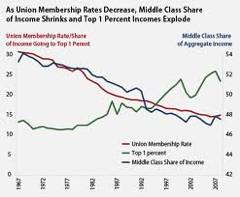
Gradually, the picket moved back to Bryant Park, the scene of Guitarmy, a DIY carnivalesque musical jam. Everyone, including bad banjoists, such as myself, was invited to take part.
When I arrived everyone was rehearsing in a collective musical skill share. I joined a few banjoists to work out the chords for “We Shall Not Be Moved.” We headed out with “This Land is Your Land.” Woody Guthrie’s prophetic words, so familiar in a chorus of voices from a new social movement, just as so many movements had sung before it. When Pete Seeger leads everyone, thousands sing along. Block after block we sang and played. Turning around I saw a man with his cello hanging around his neck, his bow finding the melody for “This Land.” And it sounded lovely. By the time we began the two chords of “One Guitar,” walking, singing and dancing, I was in my body and the music, not in my head worrying about police and income inequality. Crossing over to 30th street, most of the rally moved into the street, celebrating the joy of connection with each other, as well as the defiance of a model of citizenship which says we have to ask for permission to live democratically. Some sang and more smiled as they marched. And more and more people filled the street. Within a few minutes, police scooters started to scoot across 5th Ave. “Run around them like you are water,” one man screamed. Many of us stopped playing and scooted around. I was still picking “Angels We Heard on High” and “When the Saints Go Marching In,” watching bodies collectively move to fill our public space with our unpermitted expression of wanderlust for a more embodied, authentic expression of urban living. Police scooped around again from the other side of the street and activists ran around them again. The process went on all the way to Madison Square Park, as cat and mouse games became part of our May Day ritual. It went on like this until we joined the near 25,000 from labor and immigra tion who would rally.
|
So many lovely moments. By Giles Clark |
|
May Day at Union Square by Patricia Gardener |
|
An important message for May Day. Photo by the Rev Erik McGregor |
Walking through Union Square, I listed to the immigrant rally, compared notes with friends, and grabbed a coffee. My adrenaline, which had been oozing out of my ears as we ran away from the police, was now waning. It was a lovely energized feeling in Union Square. Members of the Plus Brigades hung out under some trees in the northwest corner of the park, joined by members of the infamous Bike Block, along with the OWS hospitality. And the Reverend Billy and Church of Stop Shopping were busy singing to union members. It was a peaceful moment after what had already been a very eventful day. I left for class at 5:30, as the rally march was starting, taught my 6 p.m. class, where we all compared notes, and returned after 8 p.m. And the union march was still going, with thousands passing Zuccotti. Looking into the distance up Broadway, bodies filled the street for as long as I could see.
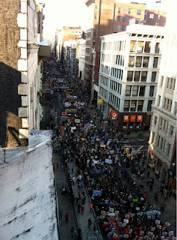 |
May Day by Patric Mccern |
The march would eventually pour past Zuccotti. As the rally ended, many of the people who had been marching, riding, running from police, twittering, and chanting since 9 a.m., were now pouring into the Blarney Stone, a pub on Trinity Place where Occupiers have been hanging out since the spring before the occupation, when we held our May 12 rally on Wall Street. We shared stories of the day. Many from the Bike Block and Church of Stop Shopping were already there when I arrived. Throughout the night people would pop in and out, in between the General Assembly taking place at the Vietnam Veteran’s memorial. Many were clearly energized by what had happened during the day. Instead of creating a day of action without a second act, OWS had gone local, joining 99 picket lines and struggles throughout the city. Radical historian Staughtyn Lynd has advised that the movement build counter institutions and traditions, rather than more opposition. And it appears this is slowly happening. Rather than the summits and days of action which propelled the global justice movement, OWS is building inroads into multiple movements. “This could last for the next ten years,” one man noted. Others talked about plans to Occupy Brooklyn College the following day. And more conversations ensued.
|
May Day General Assembly by Deborah Poo |
Over the previous six months, the movement pushed forward, inserting itself in the public consciousness, even if that meant taking arrests if need be.
Walking back to the Blarney Stone, it started to dawn on me that this was the best May Day I have been part of. Between unpermitted street actions, pickets, a mass labor rally, the Guitarmy and its chorus of songs, more voices had found expression than I imagined possible. As much as people are told to go home and take part in the democracy of consumerism and private space, countless others joined in a democracy of the streets, freedom of bodies, ideas, and dreams for another kind of city. Happy May Day Occupy!
Conclusion
Over the last year, Occupy has taken countless forms. Yet over the many other rides and pranks, from the OccuPies of March to Spring Training to Eviction Theater, play is a way of resisting the docile bodies which capitalism relies on to keep workers in check. It's been a way we can connect ideas, resist social controls, fight off despair, and break sadness as we take on inequality. “Perhaps there’s little difference between making music and making change, between creating art and new social realities #ows,” mused my friend Rosa Luxenburg. When we played cat and mouse with the police scooters on May Day, I never felt so free. And fear was as far from my mind as I could imagine.
Throughout the stories of Occupy, play takes shape in any number of forms, influencing and informing various chapters of the occupation movement. This essay merely identifies a few. Initially, it helped actors decompress and reclaim other public spaces, including the bonus plazas of New York. In later stages, it helped us reimagine social conflict as a theatrical drama, with the streets serving as stage sets. Finally, by May Day, it helped us reshape our voices into a highly participatory chorus, where we played music together, in between cat and mouse games with the police.
Through these actions, play and public performance helped us blur the lines between audience and spe ctator, release stress, disarm power, and reclaim public space as a space for authentic, colorful democracy. Through these various gestures of the im agination, we reimagined what democracy could be.
Yet no one knows where the game is moving, who are players and who are spectators. Many lessons can be glean ed from Occupy, but the occupation of a physical, public space helped open a powerful conversation about democracy. Here, the transformation of the stock exchange into a fun exchange caught fire, transforming the way we think of capitalism. Yet, as Hakim Bey reminds us, once the authorities know about a TAZ, they rarely last. This certainly was the case for the TAZ in Liberty Square. As the movement approaches its one year anniversary, others are on the way. So is the impulse to create something more enaging with our cities and their public spaces.
References
Cavanaugh, Brennan. 2011. Oral History interview with this author.
Caillois, Roger 1958/1979. Man, Play, and Games. New York: Shocken Books
Huizinga, Johan. 1938/1950. homo ludens: a study of the play element in culture. Boston: Beacon.
Jordan, John. 1998. “The Art of Necessity: the subversive imagination of anti-road protest and Reclaim the Streets,” in G. McKay Ed. DiY Culture: Party and Protest in Nineties Britain.(pp.129-51). London: Verso.
Keegan. 2012. Oral history interview with the author.
Ellis, C and Bochner, A.P. “Autoethnography, Personal Narrative, Reflexivity: Researcher As Subject” in N. Denzin and Y. Lincoln (eds.) The Handbook of Qualitative Research. 2nd Edition. Thousand Oaks, Ca.: Sage, 2000 pp. 733-768. 2000
Spontaneous Creativitiy. 2011. New York Fun Exchange (aka Occupy Wall Street). Posted 9 September 2011 from
Accessed from http://spontaneousautonomouscreativity.wordpress.com/2011/09/09/nyfe/.
Weissman, Harold. Serious Play. NASW Press. (1990)
